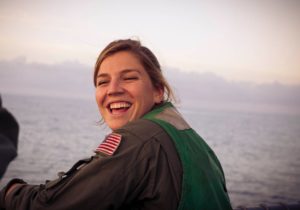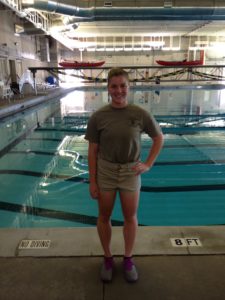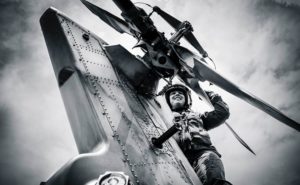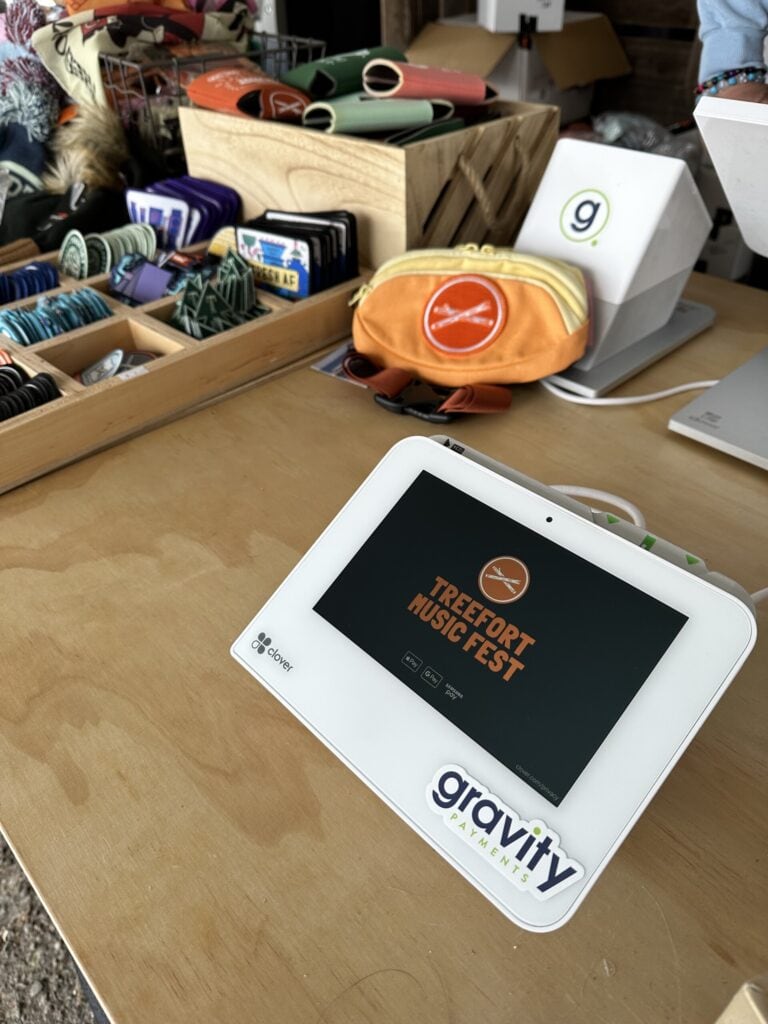The “Veterans at Gravity” series profiles employees at our company who previously served in the military. The series is part of an initiative by our in-house diversity group, Diversity and Inclusion at Gravity (DIG), to promote issues surrounding veterans in the workplace. Any views expressed are the employee’s own.
“Once I became a rescue swimmer, I was like, ‘Oh my god. I have to keep it.’”
Tori Tripoli is speaking about the two years of grueling naval training she endured on her way to becoming a rescue swimmer in the United States Navy. Growing up in Pasadena, California, Tori had always been active and athletic but had shown little interest in academics. So, as her high school graduation approached, she began to consider alternatives to college. “School just wasn’t something I was really interested in at the time, nor mature enough to focus on,” she says. “And also, the public school I attended didn’t really give the best counseling and guidance to get into college. My family didn’t know how to get into college either, so I was kind of at a loss; I didn’t know what to do.”
Get the Gravity newsletter for the latest FAQs, tools, tips and tricks
Her answer came in the form of her older brother, Clayton. Ten years Tori’s senior, Clayton had joined the Air Force right out of high school and had gone on to launch a successful career in the defense and security industry despite not having a college degree. Tori, who had always been told she was a lot like her brother in terms of personality, figured, if the military had worked for him, it could work for her, too.
She started investigating military careers and discovered the job of rescue swimmer, a special operations position that required a lot of specialized training but was open to women. “I played water polo and was on the swim team in high school, so I was like, ‘That’s dope!’” Tori says. “‘Why not? Let’s go for it!’”

Tori watching the sunset while out to sea
Even joining the military proved to be more daunting than she anticipated. “To even get a contract with the Navy, you had to meet certain physical fitness standards,” Tori says. “One of them was to do four pull-ups, and another was to do something like fifty-two push-ups. At the time, I couldn’t even do two push-ups in a row, and one pull-up was a marathon away from anything I could accomplish.”
Undeterred, Tori called a recruiter and worked out a plan. Every day, the military administers fitness tests at various locations for those applying for certain jobs. So every morning, Tori would meet her recruiter at the recruiting office and travel with him to a nearby test. Tori would take the test, fail it, and then join the rest of the would-be recruits for an afternoon of workouts and team sports before repeating the whole agenda the next day. “I just did it every single day like a full-time job,” she says. “I just kept going and taking the tests and failing, and then working out and then playing a sport, and I just did that every day until I eventually got one pull-up. And then a couple weeks later, I got two pull-ups. And then I just kept going and going and going until I was in shape enough to get a contract. My scout was like, ‘Tripoli, are you just trying to get a summer workout out of me?’ And I was like, ‘No, I promise, I’m really trying.’”
After Tori got her contract with the Navy, the real work started. For the next two years, Tori embarked on a training program so vigorous that up to fifty percent of recruits drop out before completing it. This intensity, however, serves a purpose, as rescue swimmers not only face brutal physical challenges, but also require vast amounts of technical knowledge to do their job, which is essentially to keep pilots safe by monitoring threats and rescuing them if necessary.
Tori’s journey began with a flight from California to Great Lakes, Illinois, where she completed the Navy’s basic training course. “I was on the plane, and it struck me, ‘Oh wait, I don’t have a ticket back. I’m not going home,’” Tori says. “It was the weirdest plane ride I’ve ever been on.”
After basic training, Tori was sent to Aircrew Candidate School in Pensacola, Florida, where she learned the survival and safety techniques necessary for anyone involved in aviation. “You do a lot of swimming in your flight suit,” she explains. “You learn how to tread water in a flight suit, helmet, and gloves. You jump off a tower in a flight suit and boots. You swim a mile in your flight suit.” Tori also describes an exercise called the “helo dunker,” which is essentially a waking nightmare for anyone with an aversion to confined spaces and/or being underwater. “You strap into a fake helicopter, and they submerge it completely underwater and flip it upside down, and you have to learn how to escape. Basically, the whole thing is just a long, drawn-out safety school in case your aircraft ever goes down.”
After the “basics” were out of the way, Tori started Rescue Swimmer School where she learned the ins and outs of the job. “Depending on the day,” she says, “you either get beat to death with a full workout, a running workout, and then some form of test or learning. So every morning we would do some form of land training, and then we would go on a long run, and then we would run to lunch, and then come back and do a long swim workout. Then they put you into a classroom and you have to learn whatever lesson is on for that week. Then you probably get back in the pool and practice what you learned, and then once the day’s over, you get to walk home and have your dinner. The whole point of it is obviously to teach you how to do all these situations under very high-stress environments, and not everyone makes it through. I started my Rescue Swimmer School class with maybe sixteen or seventeen people, and maybe six or seven graduated.”

Tori in front of the pool on her graduation day from Rescue Swimmer School
Tori was one of those people, which meant she could progress to the next phase of her training, AW “A” School where she learned everything there is to know about being a military aviator. “This is when I really learned that I might not be as dumb as I once thought I was,” she says. “I learned everything from oceanography, underwater sound, submarines, and radar, and because everything is secret, you can’t take it home with you, which means you have to study. I had already gone through all of these schools. There was no way that this part was going to defeat me.”
After eighteen weeks of A School, Tori flew to Maine–in the dead of winter–for Survival, Evasion, Resistance, and Escape (SERE) training. For two weeks, she learned–mostly through first-hand experience–what to do if she was ever captured behind enemy lines. “During the first week, they teach you how to navigate and survive in the wild and what to do in different scenarios if you’re ever captured,” she says. “For example, there are different protocols for if you’re captured by a terrorist or if you’re taken as an actual prisoner or war.”
During the second week of SERE, recruits put their knowledge to the test. “They essentially just drop you into the wild, and you have to hike around and survive,” Tori says. “You basically don’t eat for a week and everyone loses ten pounds. Then, halfway through the week, you start hearing gunshots and you start evading. And then you evade for a day, then they end up capturing you, and then you get sent to a terrorist camp where you get interrogated and hit and all that fun stuff. Then you get sent to a prisoner of war camp where you’re in isolation and interrogated, and it’s just super not a great time.”

Tori doing a pre-flight check of a helicopter to make sure everything was safe before takeoff
The final, and longest, part of training, Aircraft Systems, follows SERE, and it was here Tori learned how to operate a helicopter. “You learn how to fly, how to be an aircrewman, and everything about the systems that are in the helicopter.” After that, it was time for Tori to start her job as a rescue swimmer.
For the next four years, Tori worked out of San Diego where her official job title was Aircrewman Tactical Helicopter (AWR). “Basically, I sat in the back of a helicopter and did anti-submarine warfare. So I would hunt submarines or use radar to find ships and shoot torpedoes if needed at enemy submarines,” she says. “Our job was essentially to protect aircraft carriers. We were the eyes out there. We would fly in front of the ship and make sure everything was clear.”
As for swimming, Tori was always prepared to take on a rescue mission if necessary. “If a jet or any other naval aircraft were to go down, our main job was to save aviators. We were there to make sure that our pilots in the Navy were safe, especially when you’re out in the middle of nowhere in the ocean and there’s not another soul to be found.”
One thing she says was critical to success at the job: being prepared for anything. “One day I was doing an anti-submarine mission and was training someone in the back of the helicopter on how to accurately track a submarine,” Tori says, recalling a story that sums up the ever-changing nature of life in the military. “Halfway through, we got a call that someone had fallen down a ladder well on the ship and was seriously injured and needed to be flown to Hawaii for medical treatment. Almost instantly, we did a mission change. We turned back toward the ship and flew as fast as we could. We landed back on the ship and started prepping for a flight back to land. We weren’t too far away from Hawaii, but helicopters can’t fly very far without stopping for gas, so we started planning what is called a ship hop. Basically, on our way to Hawaii, we hopped from ship to ship to stop for gas along the way. What had started out as a three-hour anti-submarine mission turned into a nine-hour medical evacuation. You really need to be prepared for anything on any given day.”

Tori jumping out of a helicopter as part of Search and Rescue practice
Although Tori left the Navy after her minimum six years of service–two of training and four with her unit–the lessons have stuck with her. And while her current job as a tech support rep at ChargeItPro, Gravity’s integrated payments partner, doesn’t require her to jump out of a helicopter or read radar signals, she’s managed to apply her training in broad ways.
“The one thing I can’t thank the military enough for is that I now know there is not anything in this entire world that I can’t do,” she says. “If I want to go and be a doctor tomorrow and am willing to put in the time and the work, then I can do it. And that is something that has stuck with me. In the training and the job that I had, there was no period where I could be like, ‘I don’t know how to do that, so I’m not going to do it.’ You had to do it. You had to figure it out. And it really surprised me that if you try hard enough, you can become good at some stuff that you really don’t like. Even here at ChargeItPro, I’m like ‘Give me a job and I’ll do it. Put me in charge of the whole company. I’ll figure it out.’”
How Tori came to ChargeItPro is a story of necessity, opportunity, and circumstance. Just before leaving the Navy in the Fall of 2017, Tori and her husband, Hunter, whom she had met and married while in the military, decided to move to Boise, Idaho, where Hunter grew up. Moving to a new state and emerging into the adult world without a clear career path, Tori knew she needed to figure something out quickly. “Getting out of the military is horrifying,” she says. “It’s the scariest thing on the planet because–and I’m not the only person who has experienced this–I’d never been a real functioning adult. I joined the military, and the military took my hand and said, ‘Do this and do this,’ and I didn’t have to choose healthcare or choose a 401(k) or even choose what I did on any given day. On top of that, on the day you get out, you lose everything you’ve had. You lose your retirement, you lose your healthcare, you lose your income, and if you don’t find a job within the perfect time frame, what are you supposed to do?”
Although Tori started looking for jobs a few months before she left the Navy, she worried no employer would wait for her to be able to start. “It’s not like you can put in your two weeks’ notice,” she says. On top of that, Tori had never had a “regular” job before and wasn’t sure how to translate her military skills to office work.
“Four years is a really long time,” she says. “And for that time you’re in a military town and all of your friends are military, so you don’t even realize when you get out that you’re speaking a different language. And then when you try to put that on a resume, you hope that employers will somehow just know you’re able to this because you’re able to do that. Of course employers are looking for particular skills or management experience; They’re not looking for special ops training.”
Desperate, and not quite sure where she wanted to head in her career, Tori began furiously applying to as many opportunities in Idaho as she could find. When she got a call from ChargeItPro to come in for an interview, she wasn’t quite sure what the company did or what the job would entail, but she knew she could handle it. The question was: would the company?
“During the interview process, the people interviewing me would stop me and say, ‘I don’t know what that meant,’ and I’d be like, ‘Oh, okay, thanks for letting me know,’ because I’d told them at the outset to stop me if I sounded like I was speaking Chinese. At one point they asked me, ‘Do you have any experience with CRM,’ and I was like, ‘Oh yeah, I used CRM all the time!’ I didn’t realize that CRM stands for something different in the business world and not ‘Crew Risk Management,’ which is essentially how to not die in a helicopter.”
Luckily, despite the language barrier, ChargeItPro was not only able to see Tori’s potential but also agreed to let her start after she got out of the Navy–a full three months after she applied for her current position. “They were like, ‘Absolutely fine. We’ll wait for you, and if you need time off after you get out of the Navy, let us know and we’ll adjust to that.’ That was honestly the most amazing thing on the planet because my husband and I were both still in and were getting out around the same time, and we had no idea what we were going to do if we couldn’t find jobs. Everybody was shocked that I got a job three months out. Who hires three months out? Nobody.”
Looking back on the interview process, Tori realizes that a big part of what got her hired was her ability to show that she was a quick learner who was willing to take on any task. Recently, she asked one of the people who interviewed her why ChargeItPro hired her in the first place. “He told me that, at the end of the interview, I had been doing really well, and they asked me, ‘We’re going to ask you one of two really hard, off-the-wall interview questions. Which one do you want us to ask? One or two?’ and I said, ‘Send them both! Let’s go!’ He told me that, at that moment, they knew they wanted me on the team.”
When asked what she would like employers to know about hiring veterans, Tori points to their flexibility and adaptability. “They’re not gonna be hard to please, and they’re very quick learners,” she says. “Some of them have spent eight months on a ship, and that’s terrible. A little bit of stress isn’t going to scare them away, and they’re willing to put in the work. If you can go in the Navy and learn a job you’ve probably never even thought about before, then you’re going to be able to learn and adapt. You’re going to be good at whatever job is thrown at you.”
Tori began her job on the tech support team in January 2018, just three days after her military career ended. And while it’s taken her some time to adjust to life as a civilian–like the fact that she is now free to walk around outside without a hat on–she’s embraced her role at ChargeItPro as an opportunity to build new skills and explore career options she may not have otherwise considered. “To be honest,” she says, “I’ve had the biggest identity crisis on the planet because I don’t even know what I like anymore. I don’t really know what I like to do. You know when people say, ‘What’s your passion?’ I’m like, ‘I don’t even know what that is.’ So right now, I’m just trying to figure it out. I’ve got big dreams, and I don’t know where I want those dreams to go.”
By Brooke Carey, Content Editor




